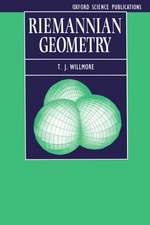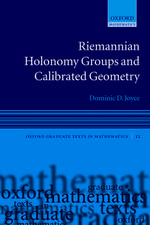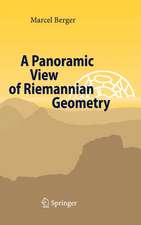Physical Applications of Homogeneous Balls: Progress in Mathematical Physics, cartea 40
Tzvi Scarr Autor Yaakov Friedmanen Limba Engleză Paperback – 23 oct 2012
The first three chapters discuss the occurrence of bounded symmetric domains (BSDs) or homogeneous balls and their algebraic structure in physics. The book further provides a discussion of how to obtain a triple algebraic structure associated to an arbitrary BSD; the relation between the geometry of the domain and the algebraic structure is explored as well. The last chapter contains a classification of BSDs revealing the connection between the classical and the exceptional domains.
Din seria Progress in Mathematical Physics
-
 Preț: 377.18 lei
Preț: 377.18 lei -
 Preț: 398.92 lei
Preț: 398.92 lei -
 Preț: 395.25 lei
Preț: 395.25 lei -
 Preț: 391.02 lei
Preț: 391.02 lei -
 Preț: 396.62 lei
Preț: 396.62 lei -
 Preț: 396.62 lei
Preț: 396.62 lei - 20%
 Preț: 481.50 lei
Preț: 481.50 lei -
 Preț: 399.29 lei
Preț: 399.29 lei -
 Preț: 391.02 lei
Preț: 391.02 lei -
 Preț: 381.98 lei
Preț: 381.98 lei - 18%
 Preț: 1239.85 lei
Preț: 1239.85 lei - 18%
 Preț: 1118.93 lei
Preț: 1118.93 lei - 15%
 Preț: 649.87 lei
Preț: 649.87 lei - 15%
 Preț: 575.10 lei
Preț: 575.10 lei - 18%
 Preț: 786.18 lei
Preț: 786.18 lei - 15%
 Preț: 656.10 lei
Preț: 656.10 lei -
 Preț: 395.25 lei
Preț: 395.25 lei -
 Preț: 382.18 lei
Preț: 382.18 lei - 15%
 Preț: 648.56 lei
Preț: 648.56 lei - 15%
 Preț: 649.06 lei
Preț: 649.06 lei - 15%
 Preț: 645.60 lei
Preț: 645.60 lei -
 Preț: 392.21 lei
Preț: 392.21 lei - 15%
 Preț: 595.86 lei
Preț: 595.86 lei -
 Preț: 409.13 lei
Preț: 409.13 lei - 15%
 Preț: 690.62 lei
Preț: 690.62 lei - 15%
 Preț: 704.69 lei
Preț: 704.69 lei - 15%
 Preț: 654.43 lei
Preț: 654.43 lei - 15%
 Preț: 646.30 lei
Preț: 646.30 lei -
 Preț: 398.35 lei
Preț: 398.35 lei -
 Preț: 402.76 lei
Preț: 402.76 lei - 15%
 Preț: 588.50 lei
Preț: 588.50 lei - 18%
 Preț: 781.62 lei
Preț: 781.62 lei -
 Preț: 408.16 lei
Preț: 408.16 lei -
 Preț: 391.79 lei
Preț: 391.79 lei
Preț: 388.72 lei
Nou
Puncte Express: 583
Preț estimativ în valută:
74.39€ • 77.38$ • 61.41£
74.39€ • 77.38$ • 61.41£
Carte tipărită la comandă
Livrare economică 14-28 aprilie
Preluare comenzi: 021 569.72.76
Specificații
ISBN-13: 9781461264934
ISBN-10: 1461264936
Pagini: 306
Ilustrații: XXIII, 279 p.
Dimensiuni: 155 x 235 x 20 mm
Greutate: 0.43 kg
Ediția:Softcover reprint of the original 1st ed. 2005
Editura: Birkhäuser Boston
Colecția Birkhäuser
Seria Progress in Mathematical Physics
Locul publicării:Boston, MA, United States
ISBN-10: 1461264936
Pagini: 306
Ilustrații: XXIII, 279 p.
Dimensiuni: 155 x 235 x 20 mm
Greutate: 0.43 kg
Ediția:Softcover reprint of the original 1st ed. 2005
Editura: Birkhäuser Boston
Colecția Birkhäuser
Seria Progress in Mathematical Physics
Locul publicării:Boston, MA, United States
Public țintă
ResearchCuprins
1 Relativity based on symmetry.- 1.1 Space-time transformation based on relativity.- 1.2 Step 6 - Identification of invariants.- 1.3 Relativistic velocity addition.- 1.4 Step 7 - The velocity ball as a bounded symmetric domain.- 1.5 Step 8 - Relativistic dynamics.- 1.6 Notes.- 2 The real spin domain.- 2.1 Symmetric velocity addition.- 2.2 Projective and conformal commutativity and associativity.- 2.3 The Lie group Aut,(Ds) 64 2.3.1 The automorphisms of Ds generated by s-velocity addition.- 2.4 The Lie Algebra autc(Ds) and the spin triple product.- 2.5 Relativistic dynamic equations on Ds.- 2.6 Perpendicular electric and magnetic fields.- 2.7 Notes.- 3 The complex spin factor and applications.- 3.1 The algebraic structure of the complex spin factor.- 3.2 Geometry of the spin factor.- 3.3 The dual space of Sn.- 3.4 The unit ball Ds,n of Sn as a bounded symmetric domain.- 3.5 The Lorentz group representations on Sn.- 3.6 Spin-2 representation in dinv (84).- 3.7 Summary of the representations of the Lorentz group on S3 and S4.- 3.8 Notes.- 4 The classical bounded symmetric domains.- 4.1 The classical domains and operators between Hilbert spaces.- 4.2 Classical domains are BSDs.- 4.3 Peirce decomposition in JC*-triples.- 4.4 Non-commutative perturbation.- 4.5 The dual space to a JC*-triple.- 4.6 The infinite-dimensional classical domains.- 4.7 Notes.- 5 The algebraic structure of homogeneous balls.- 5.1 Analytic mappings on Banach spaces.- 5.2 The group Auta (D).- 5.3 The Lie Algebra of Auta(D).- 5.4 Algebraic properties of the triple product.- 5.5 Bounded symmetric domains and JB*-triples.- 5.6 The dual of a JB*-triple.- 5.7 Facially symmetric spaces.- 5.8 Notes.- 6 Classification of JBW*-triple factors.- 6.1 Building blocks of atomic JBW*-triples.- 6.2 Methods of gluing quadrangles.- 6.3 Classification of JBW*-triple factors.- 6.4 Structure and representation of JB*-triples.- 6.5 Notes.- References.
Recenzii
From the reviews:
"The aim of this book is to present the theory of Jordan algebraic structures (Jordan triple systems) and their geometric counterpart, the so-called homogeneous balls, from the point of view of applications ot mathematical physics: special relativity, spinors and foundational quantum mechanics...The (senior) author has made important research contributions to all three areas described above, and the exposition of the theory and the applications is very careful. This makes the book suitable both for experts and non-experts interested in the applications." ---Mathematical Reviews
“This fine book provides a highly original approach to theoretical physics, its contents reflecting the author’s and his ollaborators’ copious contributions to many branches of mathematics and physics over the past years.”(ZENTRALBLATT MATH)
"The aim of this book is to present the theory of Jordan algebraic structures (Jordan triple systems) and their geometric counterpart, the so-called homogeneous balls, from the point of view of applications ot mathematical physics: special relativity, spinors and foundational quantum mechanics...The (senior) author has made important research contributions to all three areas described above, and the exposition of the theory and the applications is very careful. This makes the book suitable both for experts and non-experts interested in the applications." ---Mathematical Reviews
“This fine book provides a highly original approach to theoretical physics, its contents reflecting the author’s and his ollaborators’ copious contributions to many branches of mathematics and physics over the past years.”(ZENTRALBLATT MATH)
Textul de pe ultima copertă
One of the mathematical challenges of modern physics lies in the development of new tools to efficiently describe different branches of physics within one mathematical framework. This text introduces precisely such a broad mathematical model, one that gives a clear geometric expression of the symmetry of physical laws and is entirely determined by that symmetry.
The first three chapters discuss the occurrence of bounded symmetric domains (BSDs) or homogeneous balls and their algebraic structure in physics. It is shown that the set of all possible velocities is a BSD with respect to the projective group; the Lie algebra of this group, expressed as a triple product, defines relativistic dynamics. The particular BSD known as the spin factor is exhibited in two ways: first, as a triple representation of the Canonical Anticommutation Relations, and second, as a ball of symmetric velocities. The associated group is the conformal group, and the triple product on this domain gives a representation of the geometric product defined in Clifford algebras. It is explained why the state space of a two-state quantum mechanical system is the dual space of a spin factor. Ideas from Transmission Line Theory are used to derive the explicit form of the operator Mobius transformations. The book further provides a discussion of how to obtain a triple algebraic structure associated to an arbitrary BSD; the relation between the geometry of the domain and the algebraic structure is explored as well. The last chapter contains a classification of BSDs revealing the connection between the classical and the exceptional domains.
With its unifying approach to mathematics and physics, this work will be useful for researchers and graduate students interested in the many physical applications of bounded symmetric domains. It will also benefit a wider audience of mathematicians, physicists, and graduate students working in relativity, geometry, and Lie theory.
The first three chapters discuss the occurrence of bounded symmetric domains (BSDs) or homogeneous balls and their algebraic structure in physics. It is shown that the set of all possible velocities is a BSD with respect to the projective group; the Lie algebra of this group, expressed as a triple product, defines relativistic dynamics. The particular BSD known as the spin factor is exhibited in two ways: first, as a triple representation of the Canonical Anticommutation Relations, and second, as a ball of symmetric velocities. The associated group is the conformal group, and the triple product on this domain gives a representation of the geometric product defined in Clifford algebras. It is explained why the state space of a two-state quantum mechanical system is the dual space of a spin factor. Ideas from Transmission Line Theory are used to derive the explicit form of the operator Mobius transformations. The book further provides a discussion of how to obtain a triple algebraic structure associated to an arbitrary BSD; the relation between the geometry of the domain and the algebraic structure is explored as well. The last chapter contains a classification of BSDs revealing the connection between the classical and the exceptional domains.
With its unifying approach to mathematics and physics, this work will be useful for researchers and graduate students interested in the many physical applications of bounded symmetric domains. It will also benefit a wider audience of mathematicians, physicists, and graduate students working in relativity, geometry, and Lie theory.
Caracteristici
Develops new tools to efficiently describe different branches of physics within one mathematical framework Gives a clear geometric expression of the symmetry of physical laws Useful for researchers and graduate students interested in the many physical applications of bounded symmetric domains Will also benefit a wider audience of mathematicians, physicists, and graduate students working in relativity, geometry, and Lie theory

















